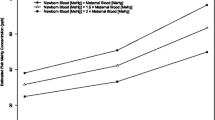Abstract
An analysis of the risk of a developmental delay or neurological impairment in children as a result of exposure to MeHg from tuna consumption was conducted. Data used as a basis for the analyses were obtained from surveys of tuna intake, MeHg concentrations in tuna, MeHg levels in the blood of pregnant women, individual relationships between dietary intake and blood levels, individual relationships between blood levels and hair levels, and individual relationships between hair levels and indices of behavioral and neurological performance. Causal or associational relationships, population variability, and uncertainty were modeled for the six data sets. Two predictive models were constructed using the model components. The first was designed to predict the risk of a delay in the onset of talking in a child of a mother who frequently consumes tuna (90 g-day-1). This model uses a one-dimensional Monte-Carlo simulation to assimilate the uncertainties. An average delay of 3-4 days was est imated. The second model was designed to compare the impact of several regulatory options on the risk among the population of tuna-eaters using a scale of central nervous system dysfunction expressly constructed for the assessment. A two-dimensional Monte-Carlo simulation was used to assimilate the distributional components describing population variability and uncertainty.
Similar content being viewed by others
References
Carrington, CD (1996). Human Ecol Risk Assess 2:62-73.
Cernichiari E, Brewer R, Myers GJ, Marsh DO, Lapham LW, Cox C, Shamlaye CF, Berlin M, Davidson PW, and Clarkson TW (1996). Neurotoxicol 16:705-709.
Cox C, Clarkson TW, Marsh DO, Amin-Zaki L, Tikriti S, and Myers GG (1989). Environ Res 49:318-332.
Kuhnert PM, Kuhnert BR, and Erhard P (1981). Am J Obstet Gynecol 139:209-213.
Lipfert FW, Moskowitz PD, Fthenakis VM, and Saroff L (1996). Neurotoxicol. 17:197-212.
Marsh, DO, Clarkson TW, Cox C, Myers GJ, Amin-Zaki L, and Al-Tikriti S. (1987). Arch. Neurol. 44:1017-1022.
Marsh DO, Clarkson TW, Myers GJ, Davidson PW, Cox C, Cernichiari E, Tanner MA, Lednar W, Shamlaye CF, Choisy O, Hoareau C, and Berlin M (1995). Neurotoxicol 16:583-596.
National Academy of Sciences (1991). Seafood Safety, NAS, Washington, DC pp 172-266.
Sherlock JC, Hislop J, Newton D, Topping G., and Whittle K (1984). Hum Toxicol 3:117-131.
Sherlock JC, Lindsay DG, Hislop JE, Evans WH, and Collier TR (1982). Arch Environ Hlth 37:271-278.
Sherlock JC and Quinn M (1988). Hum Toxicol 7:129-132.
Stern A (1993). Risk Analysis 13:355-364.
Tollefson L and Cordle F (1986). Environ Hlth Perspect 68:203-208.
World Health Organization (1990). Environmental Health Criteria 101. Methylmercury. WHO International Programme on Chemical Safety, Geneva.
Yess N (1993). J AOAC Int 76:36-38.
Author information
Authors and Affiliations
Rights and permissions
About this article
Cite this article
Carrington, C.D., Cramer, G.M. & Bolger, P.M. A Risk Assessment for Methylmercury in Tuna. Water, Air, & Soil Pollution 97, 273–283 (1997). https://doi.org/10.1023/A:1018367225334
Issue Date:
DOI: https://doi.org/10.1023/A:1018367225334




